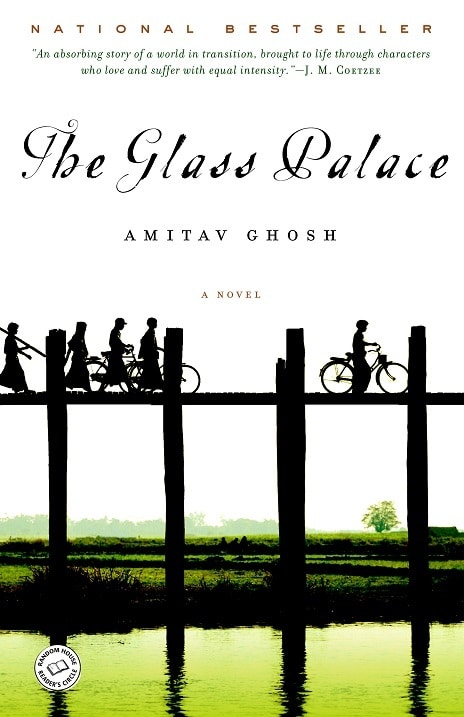For English review, please scroll down.
ארמון הזכוכית הוא רומן אפי היסטורי שאפתני המשתרע על כ – 600 עמודים. הוא מצליח להצדיק את הכתרים שקשרו לו רק ב 1/3 הראשון של הספר ואז דועך למקטעי סיפורים היסטוריים ספורדיים שמשאירים את הקורא וחצי תאוותו בידיו.
אולי זה קורה כי נראה שהמוטיבציה העיקרית בכתיבת הספר היא בראש ובראשונה תיעוד היסטורי של התהפוכות הפוליטיות והחברתיות בסוף המאה ה -19 בואכה המאה ה -20 במדינות דרום מזרח אסיה ובעיקר בבורמה (היום מיאנמר), הודו ובמלאיה. אין ספק שזוהי מראה אכזרית של המציאות שנכפתה על ילידי המדינות האלה כאשר ניגררו בעל כורחם לשיגעון הקולוניאליסטי של מדינות אירופה ומאוחר יותר של מזרח אסיה.
הקולוניאליזם הוא חיידק עמיד. הוא רק משנה צורתו ומנחיל את התכונות שלו ברמה התרבותית.
בשליש הראשון והחזק של הספר, הבריטים פולשים לבורמה ושולחים את משפחת המלוכה לגלות ברטנאגירי. מבודדת, נצורה, ובתנאים של מאסר, משפחת המלוכה ממשיכה להעמיד פנים שדבר לא השתנה במעמדם המלכותי. הסוהר הוא קולונל בריטי, סגן הנציב הבריטי בהודו, שאמור לתאם ולדאוג לכל צרכיהם. אישתו, אומה, מתיידדת עם דולי, אחת מהנערות המלוות של הנסיכות הבורמזיות.
סיפור משפחת המלוכה הבורמזית מתקדם במקביל לסיפורו של ראג'קומאר, יתום עני מהודו, שהגיע בדרך לא דרך לעיר מאנדליי בבורמה. ראג'קומאר פוגש את דולי ביום הגירוש של משפחת המלוכה ומתאהב בה מיד. הוא נשבע שיום אחד, לאחר שיתעשר, הוא ימצא את דולי וינשא לה. ואכן, ראג'קומאר התעשר ממסחר בעצי טיק ויוצא לחפש את דולי.
ככל שהסיפור מתקדם הקורא נחשף לדינמיקה של האירועים והיחסים בין השלטון הבריטי למקומיים, ובין המקומיים לבין עצמם. מערכות היחסים מתערערות ככל שהתודעה הפוליטית והלאומית של הדמויות מתעוררת וגדלה. זה לא תהליך ליניארי והוא מתרחש בעיקר במחצית השניה של הספר בה הסופר מתקדם למאה ה- 20 ומחלותיה (ובעיקר מלחמותיה).
במחצית השניה של הספר הסופר מציג לקורא מגוון דמויות ועלילות שאינן מפותחות עד הסוף, אך הן מאפשרות לסופר להשתמש בהן לתועלת הסיפור ההיסטורי.
יש משהו מאוד מתסכל בספר, כאשר הסופר רותם את הכתיבה יפיפיה והסיפור המהודק של המחצית הראשונה של הספר, להעברת מסרים ההיסטוריים והאנושיים מבלי שתהיה עלילה אמיתית. במקרה זה הסיפור הוא רק כלי שרת.
אם בחצי הראשון של הספר הסופר אמפטי לעקורים (משפחת המלוכה שנשלחה אלפי ק"מ ממקום מגוריה), שנאלצים לסבול תנאי חיים לא ראויים ואת הבושה שבמאסרם הכפוי, בהמשך האמפטיה הזו תעלם והסבל יהפוך גנרי יותר, כאשר מעט מאוד מהדמויות המקוריות והעוצמתיות של החלק הראשון ילוו את הקורא גם לחלק השני.
ככל שהסופר יפליג אל המאה ה – 20, כך הוא יתנתק מהגורם האנושי ויתחבר אל הגורם ההיסטורי. הוא ירבה לחקור את האתגרים הפוליטיים והחברתיים (כמו שאלות של זהות, השתייכות ונאמנות) ופחות יעסוק בהיבטים הרגשיים והאנושיים של האתגרים הללו.
אני כותבת את זה בצער, בשלב מסוים, בערך ב 2/3 של הספר איבדתי את הסבלנות וההקשרים בין ערב רב של הדמויות. לא הצלחתי להבין לאן העלילה הולכת. ואז הבנתי שהיא לא הולכת לשום מקום. בין הפלישה היפנית לבורמה ומלאיה, תנועת העצמאות ההודית והזוועות בבורמה המודרנית (מיאנמר) הסופר שוכח את האנשים.
כשהספר מסתיים הקורא עייף מפיסות ההיסטוריה וערב הרב של דמויות ואירועים ואין את תחושת הקתרזיס שמלווה קריאת ספרים מסוג זה.
שלושה כוכבים כי באמת השליש הראשון של הספר היה מופתי.
The Glass Palace / Amitav Ghosh
Kindle Edition, 600 pages, 2000
דירוג SIVI –
איכות אודיו –

"The Glass Palace" is a historical epic novel that spans approximately 600 pages. The author successfully justifies the main character's actions in the first third of the book but then shifts to sporadic historical segments that can leave the reader feeling unfulfilled.
It seems that the primary motivation behind writing the book is to create a historical record of the political and social upheavals that occurred at the end of the 19th century and the beginning of the 20th century in Southeast Asian countries such as Burma (now Myanmar), India, and Malaya. These countries were unwillingly dragged into the colonial madness of Europe and East Asia, which imposed a cruel reality on the natives. The book serves as a mirror of this reality.
Colonialism is a persistent germ, only changing its form while inflicting its attributes on the cultural level.
In the first and strongest third of the book, we follow the story of the British invasion of Burma and how they forced the royal family into exile in Ratnagiri. Despite being isolated, besieged, and imprisoned, the royal family maintained their regal pretenses. The warden in charge is a British colonel, who also happens to be the Deputy Commissioner in India, responsible for all of their needs. Meanwhile, Uma, the wife of the warden, develops a friendship with Dolly, one of the attendant girls of the Burmese princesses.
The story follows the Burmese royal family and Rajkumar, a poor orphan from India who arrives in Mandalay, Burma via a difficult journey. On the day of the royal family's deportation, Rajkumar meets Dolly and falls in love with her instantly. He promises to find her and marry her once he becomes rich. After achieving wealth through the teak trade, Rajkumar sets out to fulfill his promise and find Dolly.
Throughout the course of the story, the reader is exposed to the complex dynamics of events and relationships between the British government, the locals, and the locals themselves. As the political and national consciousness of the characters awaken and develop, these relationships become undermined. This is not a linear process and is mainly explored in the second half of the book, where the author delves into the 20th century with its diseases, wars, and the impact they have on the characters.
In the second half of the book, the author introduces a variety of characters and plots that serve to complement the historical story, even though they are not fully developed.
There is a certain level of frustration in the book caused by the author's use of beautiful writing and a tight story in the first half to convey historical and human messages without a proper plot. In this case, the story is merely a tool to convey the author's message.
If the writer shows empathy towards the displaced in the first half of the book, specifically the royal family who are sent thousands of kilometers away from their home and forced to endure inappropriate living conditions and the shame of their forced imprisonment, later on in the book this empathy disappears. The suffering becomes more generic, as very few of the original and influential characters from the first part will accompany the reader into the second part.
As the writer progressed into the 20th century, he tended to shift his focus from the emotional and human aspects of political and social challenges to their historical and factual elements. This means that he would more frequently explore the political and social challenges of the time, such as questions of identity, belonging, and loyalty, and less often delve into their emotional and human dimensions.
It is with deep sadness that I write this. I enjoyed the book until about two-thirds of the way through. At that point, I lost patience with the confusing connections between many of the characters. I couldn't figure out where the plot was heading. Then it dawned on me that the story wasn't headed anywhere. The author seemed to have lost focus on the people amidst the backdrop of the Japanese invasion of Burma and Malaya, the Indian independence movement, and the atrocities in modern-day Myanmar.
When the book ends, the reader may feel exhausted from the vast array of historical details and characters, without the satisfaction of a cathartic resolution commonly found in similar works.
The book deserves three stars because the first third of it was masterfully written.
לגלות עוד מהאתר Sivi's Books
Subscribe to get the latest posts sent to your email.

